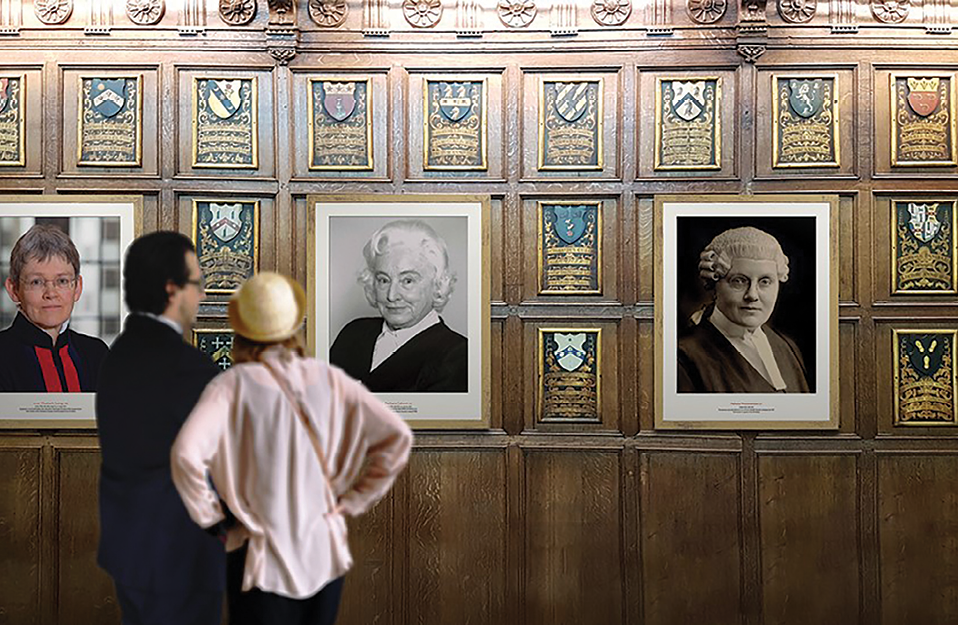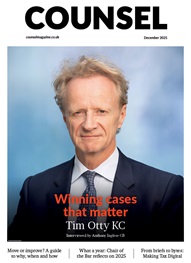*/

The Centenary of Women in Law at the Royal Courts of Justice and Celebrating a Century of Women in Law at the Honourable Society of the Middle Temple
I must admit that when I was asked to review these two exhibitions for Counsel magazine, I was both apprehensive and a little sceptical of what they might involve. I have thoroughly enjoyed and appreciated the variety of projects, particularly online, that have celebrated this important anniversary in the role of women in law, but found it difficult to imagine how an exhibition on such a topic could work. My greatest fear was that it would either be too brash and forced or a little too dull to invoke any real feeling or public engagement.
I am glad to say I was sorely mistaken on both fronts, when I took the opportunity to visit the sister exhibits at the Middle Temple and the Royal Courts of Justice (RCJ).
The RCJ exhibition largely consists of freestanding banners presented throughout its stunning and opulent foyer. Each of these displays contains information regarding the progress of notable trailblazers who were instrumental in breaking the glass ceiling in pursuit of access for women into the legal profession. The banners are striking; a notable mix of black and white imagery of a variety of important female legal minds, etched on to a striking red border summarising key dates and developments. They stand proudly in the centre of the courts’ grand entrance such that every advocate and ardent tourist must pass through them.
The display certainly stands out and made its point admirably, yet there was a part of me that wondered whether it felt a little too transient. The banners themselves are rather similar to corporate banners used by law firms and the readily moveable nature of the display, whilst entirely understandable on a practical level, made the exhibition feel a bit too ‘pop-up’ for me, rather than a key celebration of a pivotal anniversary.
In contrast, the Honourable Society of the Middle Temple has taken, what feels like, a more permanent approach to its display. Mounted in clear, modern frames on the walls of its iconic 16th century hall, under the dazzling double vaulted ceilings, are large portraits of female Middle Templars, recognised for their contribution to the advancement of women in the profession. The portraits are of a size significant enough to stand out amongst the copious Middle Temple artwork, but curated with absolute ease into the historic decor and crests that adorn the walls of the Great Hall. I have to admit that something about the manner in which this exhibition was curated and how the images of these pioneering women seamlessly integrate with the tradition that permeates Middle Temple Hall, was particularly inspiring. There could have been a real risk that the images simply faded in the face of the priceless and decadent artefacts contained within the Hall, but somehow the exhibition has been fashioned in a manner where that does not happen.
In contrast to the RCJ, however, the exhibition itself is largely confined to the walls of Middle Temple Hall. An interactive panel just outside the entrance doors provides extra information on each trailblazer featured in the portraits and other noteworthy women. Whereas the RCJ exhibition was set in the grand foyer, ensuring prime attention and focus, the Middle Temple exhibition is perhaps reserved for those interested enough to traverse the edges of the Hall with that particular purpose in mind.
All that being said, both of these exhibitions really do serve to display, in a very real-world manner, the achievements and importance of this centenary anniversary. Whilst the online attention has been vast for this project, there is something quite grounding and unmistakably real in seeing these individuals commemorated and celebrated in the exact hallowed halls and courts to which they fought for the right for all women to have access. The victory is almost tangible when one gazes upon their portraits and likenesses emblazoned across exhibitions of this kind. I, for one, would not object at all to the exhibition within the RCJ, which seems ideal for transferring, to make its away across the larger court centres of England and Wales. It seems only fitting for these ground-breaking women and their deeds to be displayed not only in London but throughout the jurisdiction of their achievements. ●
Whilst the online attention has been vast for this project, there is something quite grounding and unmistakably real in seeing these individuals commemorated and celebrated in the exact hallowed halls which they fought for the right for all women to have access to.

I must admit that when I was asked to review these two exhibitions for Counsel magazine, I was both apprehensive and a little sceptical of what they might involve. I have thoroughly enjoyed and appreciated the variety of projects, particularly online, that have celebrated this important anniversary in the role of women in law, but found it difficult to imagine how an exhibition on such a topic could work. My greatest fear was that it would either be too brash and forced or a little too dull to invoke any real feeling or public engagement.
I am glad to say I was sorely mistaken on both fronts, when I took the opportunity to visit the sister exhibits at the Middle Temple and the Royal Courts of Justice (RCJ).
The RCJ exhibition largely consists of freestanding banners presented throughout its stunning and opulent foyer. Each of these displays contains information regarding the progress of notable trailblazers who were instrumental in breaking the glass ceiling in pursuit of access for women into the legal profession. The banners are striking; a notable mix of black and white imagery of a variety of important female legal minds, etched on to a striking red border summarising key dates and developments. They stand proudly in the centre of the courts’ grand entrance such that every advocate and ardent tourist must pass through them.
The display certainly stands out and made its point admirably, yet there was a part of me that wondered whether it felt a little too transient. The banners themselves are rather similar to corporate banners used by law firms and the readily moveable nature of the display, whilst entirely understandable on a practical level, made the exhibition feel a bit too ‘pop-up’ for me, rather than a key celebration of a pivotal anniversary.
In contrast, the Honourable Society of the Middle Temple has taken, what feels like, a more permanent approach to its display. Mounted in clear, modern frames on the walls of its iconic 16th century hall, under the dazzling double vaulted ceilings, are large portraits of female Middle Templars, recognised for their contribution to the advancement of women in the profession. The portraits are of a size significant enough to stand out amongst the copious Middle Temple artwork, but curated with absolute ease into the historic decor and crests that adorn the walls of the Great Hall. I have to admit that something about the manner in which this exhibition was curated and how the images of these pioneering women seamlessly integrate with the tradition that permeates Middle Temple Hall, was particularly inspiring. There could have been a real risk that the images simply faded in the face of the priceless and decadent artefacts contained within the Hall, but somehow the exhibition has been fashioned in a manner where that does not happen.
In contrast to the RCJ, however, the exhibition itself is largely confined to the walls of Middle Temple Hall. An interactive panel just outside the entrance doors provides extra information on each trailblazer featured in the portraits and other noteworthy women. Whereas the RCJ exhibition was set in the grand foyer, ensuring prime attention and focus, the Middle Temple exhibition is perhaps reserved for those interested enough to traverse the edges of the Hall with that particular purpose in mind.
All that being said, both of these exhibitions really do serve to display, in a very real-world manner, the achievements and importance of this centenary anniversary. Whilst the online attention has been vast for this project, there is something quite grounding and unmistakably real in seeing these individuals commemorated and celebrated in the exact hallowed halls and courts to which they fought for the right for all women to have access. The victory is almost tangible when one gazes upon their portraits and likenesses emblazoned across exhibitions of this kind. I, for one, would not object at all to the exhibition within the RCJ, which seems ideal for transferring, to make its away across the larger court centres of England and Wales. It seems only fitting for these ground-breaking women and their deeds to be displayed not only in London but throughout the jurisdiction of their achievements. ●
Whilst the online attention has been vast for this project, there is something quite grounding and unmistakably real in seeing these individuals commemorated and celebrated in the exact hallowed halls which they fought for the right for all women to have access to.
The Centenary of Women in Law at the Royal Courts of Justice and Celebrating a Century of Women in Law at the Honourable Society of the Middle Temple


Chair of the Bar reflects on 2025
AlphaBiolabs has donated £500 to The Christie Charity through its Giving Back initiative, helping to support cancer care, treatment and research across Greater Manchester, Cheshire and further afield
Q&A with criminal barrister Nick Murphy, who moved to New Park Court Chambers on the North Eastern Circuit in search of a better work-life balance
Revolt Cycling in Holborn, London’s first sustainable fitness studio, invites barristers to join the revolution – turning pedal power into clean energy
Rachel Davenport, Co-founder and Director at AlphaBiolabs, reflects on how the company’s Giving Back ethos continues to make a difference to communities across the UK
By Marie Law, Director of Toxicology at AlphaBiolabs
Are you ready for the new way to do tax returns? David Southern KC explains the biggest change since HMRC launched self-assessment more than 30 years ago... and its impact on the Bar
Professor Dominic Regan and Seán Jones KC present their best buys for this holiday season
Marking one year since a Bar disciplinary tribunal dismissed all charges against her, Dr Charlotte Proudman discusses the experience, her formative years and next steps. Interview by Anthony Inglese CB
Little has changed since Burns v Burns . Cohabiting couples deserve better than to be left on the blasted heath with the existing witch’s brew for another four decades, argues Christopher Stirling
Pointillism, radical politics and social conscience. Review by Stephen Cragg KC